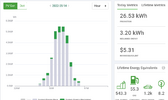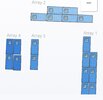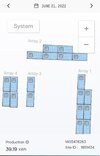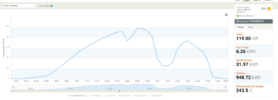Welcome to Tesla Motors Club
Discuss Tesla's Model S, Model 3, Model X, Model Y, Cybertruck, Roadster and More.
Register
Install the app
How to install the app on iOS
You can install our site as a web app on your iOS device by utilizing the Add to Home Screen feature in Safari. Please see this thread for more details on this.
Note: This feature may not be available in some browsers.
-
Want to remove ads? Register an account and login to see fewer ads, and become a Supporting Member to remove almost all ads.
You are using an out of date browser. It may not display this or other websites correctly.
You should upgrade or use an alternative browser.
You should upgrade or use an alternative browser.
Optimizers... what are they good for?
- Thread starter nwdiver
- Start date
I have a lot of shading that moves around during the day on one of my strings. I put Tigo optimizers on those panels.
According to Tigo, I am "reclaiming" a fair amount of energy.
View attachment 804373
It would be interesting to see how that calculation is being determined. I hadn't logged into my Tigo account in a while. I guess this is a new feature? This is what mine shows. But there's no shade at all so how does it filter reclaimed energy?
And.... this is odd. I think this shows reclaimed power panel by panel... but only B2 has an optimizer... the other panels are RSDs.
100% an optimizer will 'reclaim' some energy from a FULLY shaded panel. I'm just skeptical that adds up to anything significant. Once a cell is in shade that cell group is removed from the string so the output is 0w. But you need shade across ALL cell groups for there to be a difference. If just one cell group is in shade that cell group would still be removed in an optimized panel. You can see that effect here... A4 and A7 have lost a cell group. This is panel voltage.
Last edited:
mspohr
Well-Known Member
I think Tigo can reclaim energy by boosting from shaded panels rather than just having the bypass diodes kick in.It would be interesting to see how that calculation is being determined. I hadn't logged into my Tigo account in a while. I guess this is a new feature? This is what mine shows. But there's no shade at all so how does it filter reclaimed energy?
View attachment 804375
And.... this is odd. I think this shows reclaimed power panel by panel... but only B2 has an optimizer... the other panels are RSDs.
View attachment 804377
100% an optimizer will 'reclaim' some energy from a FULLY shaded panel. I'm just skeptical that adds up to anything significant. Once a cell is in shade that cell group is removed from the string so the output is 0w. But you need shade across ALL cell groups for there to be a difference. If just one cell group is in shade that cell group would still be removed in an optimized panel. You can see that effect here... A4 and A7 have lost a cell group. This is panel voltage.
View attachment 804378
. The optimizer "senses" a reduction in current caused by some shading. It adjusts this module's current to reflect the correct “virtual” resistance for each module, thus preventing the lower producing module from dragging down the production of the higher producing modules in the string.
I think Tigo can reclaim energy by boosting from shaded panels rather than just having the bypass diodes kick in.
. The optimizer "senses" a reduction in current caused by some shading. It adjusts this module's current to reflect the correct “virtual” resistance for each module, thus preventing the lower producing module from dragging down the production of the higher producing modules in the string.
Yes. That certainly is the way it works but that only applies to a FULLY shaded module. The optimizer is on the panel level. If you have a 300w panel with 2 cells in a cell group shaded you're gonna get the most power out of that panel by bypassing that cell group to get 200w instead of dropping current to ~1A to get 30w. So in the end there's either not much of a difference between optimized and non-optimized or it's just blood from a stone.
100% if these panels didn't have optimizers the output of panel 13 would be 0w not 30w. I just don't see how 30w adds up to that much reclaimed energy. Even if it was shaded the entire day that's only ~300wh.
Optimizers allow current between PANELS to be different but current between CELL GROUPS within a panel cannot change and that's what triggers bypass diodes.
Last edited:
mspohr
Well-Known Member
Yes, my example used a fully shaded panel. However, impedance matching works with partial shading.Yes. That certainly is the way it works but that only applies to a FULLY shaded module. The optimizer is on the panel level. If you have a 300w panel with 2 cells in a cell group shaded you're gonna get the most power out of that panel by bypassing that cell group to get 200w instead of dropping current to ~1A to get 30w. So in the end there's either not much of a difference between optimized and non-optimized or it's just blood from a stone.
100% if these panels didn't have optimizers the output of panel 13 would be 0w not 30w. I just don't see how 30w adds up to that much reclaimed energy. Even if it was shaded the entire day that's only ~300wh.
View attachment 804427
Impedance matching can be understood with the help of a loose analogy to a water pipe composed of sections of varying diameter. Panels with higher generating capacity, such as the one on the left (150 watts), are like pipe sections with a large diameter; the middle panel, operating at only 50 watts, represents a narrower pipe.
A 50W module will produce less current than a 150W module
Connecting panels of varying output in a string is analogous to connecting pipe segments of different diameter—of course the narrow sections will affect the way water flows through the entire structure. Similarly, panels with low generating capacity bring down the efficiency of the entire array. The flow of current through lower generating panels is impaired in two important ways:
The weaker panel will have to handle higher current than it is able to, thus resulting in heat dissipation
The weaker panel will start to leak, further decreasing the overall power output of the string
Tigo's Impedance Matching technology provides a solution to the problems caused by panel mismatch. Tigo’s patented approach creates a parallel path for current to flow around weak panels, enabling an optimal flow of energy. This bypass tunnel maintains the optimal flow of energy throughout the string.
wwu123
Active Member
I just submitted online to Tesla for a 4.8kw system + 1 Powerwall, as an expansion of my current 4 kw Enphase micro system. The only spot for the new panels will be an east-facing roof plane sitting between two south-facing planes where the current panels are split evenly. Based on the Enphase panel level monitoring, I can see the morning tree shading roll across the existing arrays over a two-hour period each morning until the array is fully in sun., and then the afternoon tree-shading roll across the arrays over two-hours until they're completely shaded. Each individual panel takes about 30 min to go from min to max, and then back to min - this time of year, for example each panel does get between 5-7 hours of full sun mid-day
Even with the morning and afternoon shading, I was able to attain about a 7-year payback period, due to good south-facing production, previously grandfathered PG&E rate plans, and their relentless increase of rates.
The east-facing plane for the new Tesla system will have the same shading patterns since it sits between the existing arrays. I'm certainly hoping that Tesla's string inverter technology together with modern half-cut cells will still get decent shade production compared to micro's, since the strings will spend four hours each day at least partly shaded, nearly as much as they spend fully lit. I'm not expecting a 7-year payback period again, but I can plan to be here a while so if I can get at least enough efficiency for a 15-year payback period, I can take the long view.
Even with the morning and afternoon shading, I was able to attain about a 7-year payback period, due to good south-facing production, previously grandfathered PG&E rate plans, and their relentless increase of rates.
The east-facing plane for the new Tesla system will have the same shading patterns since it sits between the existing arrays. I'm certainly hoping that Tesla's string inverter technology together with modern half-cut cells will still get decent shade production compared to micro's, since the strings will spend four hours each day at least partly shaded, nearly as much as they spend fully lit. I'm not expecting a 7-year payback period again, but I can plan to be here a while so if I can get at least enough efficiency for a 15-year payback period, I can take the long view.
Yes, my example used a fully shaded panel. However, impedance matching works with partial shading.
Impedance matching can be understood with the help of a loose analogy to a water pipe composed of sections of varying diameter. Panels with higher generating capacity, such as the one on the left (150 watts), are like pipe sections with a large diameter; the middle panel, operating at only 50 watts, represents a narrower pipe.
A 50W module will produce less current than a 150W module
Connecting panels of varying output in a string is analogous to connecting pipe segments of different diameter—of course the narrow sections will affect the way water flows through the entire structure. Similarly, panels with low generating capacity bring down the efficiency of the entire array. The flow of current through lower generating panels is impaired in two important ways:
The weaker panel will have to handle higher current than it is able to, thus resulting in heat dissipation
The weaker panel will start to leak, further decreasing the overall power output of the string
Tigo's Impedance Matching technology provides a solution to the problems caused by panel mismatch. Tigo’s patented approach creates a parallel path for current to flow around weak panels, enabling an optimal flow of energy. This bypass tunnel maintains the optimal flow of energy throughout the string.
That was essentially what I wanted to dispel with my post about de-limiting that string. The loss of efficiency panel to panel isn't that significant. As I discovered today you can be ~6% off the MPP but only lose ~0.4% of production. I was a bit surprised. I expected a gain of ~200w but only got 14w. I think you have a misunderstanding of how the current works. If your 150w panel is in full sun and your 50w panel is 1/3 sun with 2/3 cell groups shaded each panel in this array has the same current.
Different power, same current. The tiny mismatch is a measurement error. This is a non-optimized string so by Ohms law the current through each panel is the same. It's voltage that's changing.
Power
Current
Voltage
The mismatch in current is mostly offset by a different voltage. If a panels MPP is 9A but the string tracker has string current at 8.8A that panel will just have a slightly higher voltage and very little production is lost.
This is actually a mismatched array. Right most 2 panels on the top and bottom were added about a year later. They're 330s and the other panels are 310s. Their MPP is a higher current than the others but it's naturally compensated for with a higher voltage.
Last edited:
*sigh* misinformation never dies. CNET should know better....
'The downside of string inverters is that they're a bit of a blunter tool than their microinverter counterparts. Because they handle whole groups of panels at once, a dip in production in one panel brings down the performance of all the panels. If one of the panels in a string is shaded and produces less power, every panel in the string produces at that lower level. A roof that's partially shaded throughout the day might be better suited to microinverters.'
'The downside of string inverters is that they're a bit of a blunter tool than their microinverter counterparts. Because they handle whole groups of panels at once, a dip in production in one panel brings down the performance of all the panels. If one of the panels in a string is shaded and produces less power, every panel in the string produces at that lower level. A roof that's partially shaded throughout the day might be better suited to microinverters.'
sorka
Well-Known Member
Except that the article follows that ^^^^ with this:*sigh* misinformation never dies. CNET should know better....
'The downside of string inverters is that they're a bit of a blunter tool than their microinverter counterparts. Because they handle whole groups of panels at once, a dip in production in one panel brings down the performance of all the panels. If one of the panels in a string is shaded and produces less power, every panel in the string produces at that lower level. A roof that's partially shaded throughout the day might be better suited to microinverters.'
"A solar panel system might also use a string inverter with power optimizers. Power optimizers don't convert the electricity to alternating current. That still happens in one place at the string inverter. Instead, power optimizers make it possible for panels to produce independently of each other. If one is shaded, the others can carry on. More or less, power optimizers and microinverters accomplish the same job in different ways."
Except that the article follows that ^^^^ with this:
"A solar panel system might also use a string inverter with power optimizers. Power optimizers don't convert the electricity to alternating current. That still happens in one place at the string inverter. Instead, power optimizers make it possible for panels to produce independently of each other. If one is shaded, the others can carry on. More or less, power optimizers and microinverters accomplish the same job in different ways."
Point is that it's perpetuating the myth that shading one panel will degrade the performance of unshaded panels. This doesn't occur in properly installed string systems. You don't need optimizers to prevent this. Just bypass diodes which every solar panel has.
mspohr
Well-Known Member
He's technically competent but doesn't seem to understand optimizers and just repeats the usual criticisms of others.Pretty deep dive into the optimizer abyss.
He seems to think that a bypass diode is equivalent to an optimizer. (Yes, it will prevent complete blockage of a string but does nothing to recover power from a partially shaded panel.)
He seems to think that a bypass diode is equivalent to an optimizer.
Pretty sure he was just being a bit cheeky when he called it an 'optimizer'. In another part of the video he explains exactly what optimizers are and how they work. Although... in a strictly literal sense... the bypass diodes do 'optimize' performance compared to no bypass diodes so
He also showed how under most shade conditions the optimizer won't recover any additional energy either unless additional bypass diodes are added to the panel.
Last edited:
skepticcyclist
Member
When they installed mine I got quotes for MI, optimizers, and strings without either. They ended up recommending MIs for my situation because I have a complex roof system where panels are facing east, west, and south in groups of 2, 4, 6, and 7. They had to put some of the east, west, and south panels together a in string, which could effect overall production. Because the installation labor cost was less expensive with MIs, even though equipment costs was more, the overall cost compared to going with a string inverter was close to the same. Because I would get slightly better overall production for the a similar price, I went with micros. The most expensive quote was the string with optimizers because of labor and equipment.
You can see the consistent production of the different orientations (this was yesterday on a clear day.) South panels all producing the most. East second most. West worst (sun goes behind a hill a couple hours before sunset and my neighbors tree to the west shades those panels in late afternoon.) Of course this is really only an issue from late fall to early spring.
Ignore the naming system. I just named it arrays 1-4 on my own right after I got access to the APP. I didn’t know how they were stringed together until I helped the roofers remove them and put them back up when my house got reroofed. Array 1 and 3 face west, 4 faces east, 2 faces south
You can see the consistent production of the different orientations (this was yesterday on a clear day.) South panels all producing the most. East second most. West worst (sun goes behind a hill a couple hours before sunset and my neighbors tree to the west shades those panels in late afternoon.) Of course this is really only an issue from late fall to early spring.
Ignore the naming system. I just named it arrays 1-4 on my own right after I got access to the APP. I didn’t know how they were stringed together until I helped the roofers remove them and put them back up when my house got reroofed. Array 1 and 3 face west, 4 faces east, 2 faces south
Attachments
Last edited:
skepticcyclist
Member
When they installed mine I got quotes for MI, optimizers, and strings without either. They ended up recommending MIs for my situation because I have a complex roof system where panels are facing east, west, and south in groups of 2, 4, 6, and 7.
Yep. If that was the exclusive use case pitched by SE and Enphase this thread wouldn't exist.
The only task optimizers are suited for is allowing panels in the same string to face different directions.
skepticcyclist
Member
This is my lowest producing panel yesterday, the one that is most impacted by my neighbor's tree to the SW of me. This panels gets completely shaded around 3:00. The power drops significantly, but it still produces. As it becomes less shaded as the shadow moves out of the way, production goes back up.
Attachments
mspohr
Well-Known Member
nwdiver said:
The only task optimizers are suited for is allowing panels in the same string to face different directions.
... and shading (panels facing different directions is the same as shading).
This is my lowest producing panel yesterday, the one that is most impacted by my neighbor's tree to the SW of me. This panels gets completely shaded around 3:00. The power drops significantly, but it still produces. As it becomes less shaded as the shadow moves out of the way, production goes back up.
True. But the ability for that panel to operate independently from a string for that hour is gaining ~40wh/day? ~15kWh/yr? Optimization generally adds ~$0.30/w to the cost of a system. So for a 300w panel that's a ~$90 cost increase to gain ~15kWh/yr. Even if you're paying $0.50/kWh that's not a great return. Even worse if you're looking to optimize an entire array to salvage a few wh from a few panels when there's shade.
Sure, your use case is different since you had no other option due to your configuration. But for larger systems that DO have the option...
nwdiver said:
The only task optimizers are suited for is allowing panels in the same string to face different directions.
... and shading (panels facing different directions is the same as shading).
Not really. In the first case you're losing some energy always. With shading you're losing some energy, sometimes, maybe. There are shading conditions where there's no benefit such as when only one cell group is shaded. With different orientations there's ~always some benefit to operating on a separate MPP. Different orientations on the same MPPT also means it's possible to impede the performance of unshaded panels which generally doesn't happen with shade.
Last edited:
mspohr
Well-Known Member
I installed Tigo optimizers on an array which has lots of tree shade (particularly in winter).
Cost was $45/panel so about 0.12/W. The optimizer itself is 99.5% efficient so no penalty in full sun. The optimizers give me 20-25% more energy so this array generates about an extra 1.2 MWh per year. At $200/MWh payback is about two years.
Cost was $45/panel so about 0.12/W. The optimizer itself is 99.5% efficient so no penalty in full sun. The optimizers give me 20-25% more energy so this array generates about an extra 1.2 MWh per year. At $200/MWh payback is about two years.
Similar threads
- Replies
- 32
- Views
- 930
- Replies
- 17
- Views
- 1K
- Replies
- 4
- Views
- 2K
- Replies
- 5
- Views
- 840






